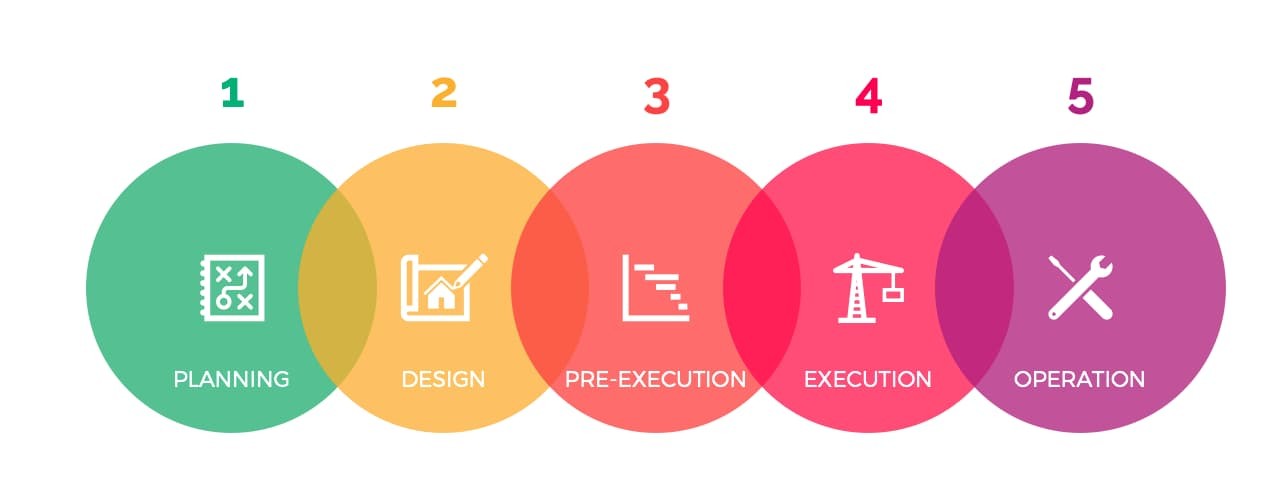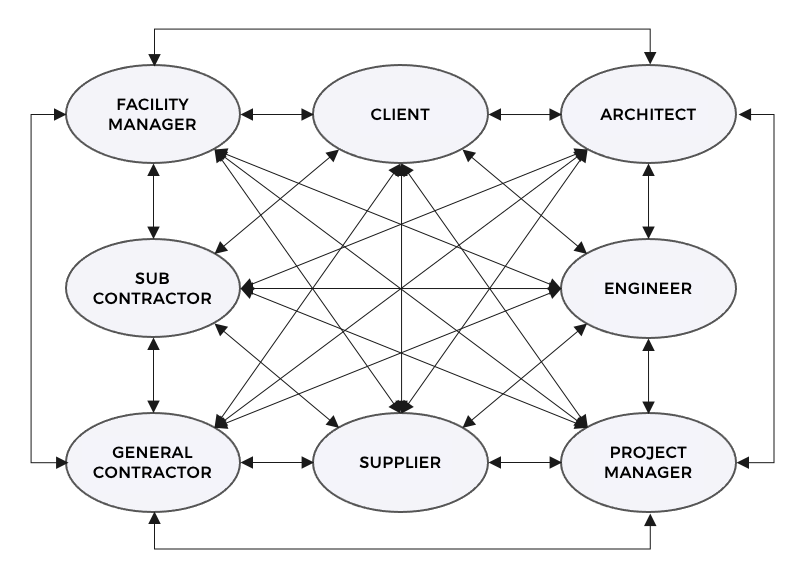Ensuring that the bulk of information is accurate and available for all stakeholders is a key requirement for construction projects to be completed on time and budget, and according to quality standards. We also mentioned that access to a data infrastructure is an indispensable tool in modern construction management to aid the effective creation, storage, sharing, and usage of information in a timely manner. Considering the need to provide a better understanding of the concept of data management in the construction sector, it becomes pertinent to begin by highlighting the different types of information in a construction project [1].
Types of Infon in a Construction Project
Have you ever wondered what it takes to construct a building or a highway? As mentioned in our previous blog post, construction is a complex and information-intensive undertaking which involves lots of interconnected activities between multiple stakeholders with massive amounts of data generated across different stages.
What is Construction Information?
Construction information can be referred to as every form of information related to a construction project. There are different types of construction information which evolve as the project progresses. Information can be categorized according to different stages of a construction project which also determines how it is created and used.

Planning Information:
Planning information includes all information related to the early stage of the project. This consist of feasibility studies which allow the owner to evaluate the viability of the project and determine the most appropriate options in terms of economic and technical requirements. This is made up of the needs assessments; site surveys; existing environmental conditions; environmental impact assessments; needs assessments; requirements for development permits; cost analysis; spatial requirements; technical requirements; business plans; contracting options; etc. The client/owner is responsible for providing the information at this stage with the purpose of conducting an appraisal of the proposed development. For large projects, a business development team with expertise in real estate takes up such responsibilities. It also becomes useful information for the designers and contractors as the project progresses [2].
Design Information:
Design information is made up of all information created at the design stage of the project. It includes all visual and non-visual information related to the proposals by the design team. They consist of conceptual drawings; detailed drawings; specifications; accommodation schedules; cost plan; timelines; buildability reports; calculations; etc. Depending on the size of the project, a design team can consist of architects, structural engineers, civil engineers, mechanical engineers, electrical engineers, plumbing engineers, geotechnical engineers, landscape designers, interior designers, lighting designers, sustainability experts, etc. Each member of the team will be responsible for providing unique sets of information. In the past, design information was created in the form of 2-dimensional drawings and 3-dimensional models through pen and paper as well as computer-aided design (CAD) tools. However, the recent adoption of Building Information Modelling (BIM) has provided designers with better and enhanced tools to create, capture, represent, and share design information related to a building or infrastructure. Just as information at the planning stage is vital for the design team, design information will be useful for contractors and owners as the project progresses. In summary, design information provides a broad picture of what is expected to be built [3].
Execution Information:
Execution information encompasses all information related to the execution phase of the project, i.e. the construction phase in which the physical works on the construction site begins. It contains all information of construction as works progress on site. They may consist of construction schedules; cost estimates and budgets; shop drawings; as-built drawings; contracts; regulatory permits; request for information (RFI); field reports; time and material tags; payment records; etc. Most of the information at this stage is generated by the general contractor and sub-contractors along with their teams of foremen, crews, and vendors. Project management tools and BIM are used to create, share, and store such information. As the works continues, the data captured during this stage will ideally be used to measure the progress of works in comparison to the data generated during the pre-execution stage. This way, construction teams can have a better picture of whether the targets are being met or what changes are affecting the project. Therefore, it becomes necessary to provide adequate links between information created during pre-execution and execution stages. After the completion of the execution of building works, the information generated will be most helpful to the owner during the operation and use of the built asset.
Operation Information:
Operation information refers to the information that is related to the use of the building or facility that has been constructed. The main purpose of the information in this phase is to support the operation and maintenance of the building in its daily life. It may include tenancy records; energy and utilities consumption; maintenance schedules; equipment records; post-occupancy evaluation; contracts etc. The use of digital tools such as Computer-Aided Facilities Management (CAFM) and Computerized Maintenance Management Systems (CMMS) have become a game changer for the creation and organization of operation information. Likewise, the integration of a BIM model generated from the execution stage can be used in the form of an Asset Information Model (AIM) at the operation stage. An AIM is a model that compiles the data and information necessary to support asset management where a 3-dimensional model can be used to visualize the physical performance of spaces, equipment, and the structure over time. At this stage, the owner of the facility is the sole creator and user of information with no input from the design and execution teams. However, the information will be required for future design and execution purpose in the case of a redevelopment or expansion. Additionally, the information will be valuable for the planning phase of similar projects in the future [5].
Other Information:
Unlike the above-mentioned types of information that are specific to the stage of a construction project, there are other types of information that are not restricted to any specific period or stakeholder but are equally important. These types of information are referred to as “Communications”. Imagine the number of correspondences happening in a construction project via letters, phone calls, video calls, text messages, site meetings etc. A mega construction project could involve about 50 different organizations working at different stages of the project. It is the responsibility of the project manager to manage all communications throughout the project which tends to be a tedious task. When teams don’t communicate effectively, delays or mistakes tend to occur which affects the performance of the project [6]. In the past, correspondence was done via paper and post but the emergence of digital communication tools such as messengers, email, and team management apps have transformed how people communicate in a construction project. Also, the use of BIM-enabled tools has helped to centralize communication with the use of a common data environment (CDE).

Concluding thoughts
In summary, construction information is unique and comes with diverse types of formats and uses. This breeds a new set of challenge as it is common to find that most organizations working on a construction project operate with different tools and processes due to the fragmented nature of the industry. Although BIM was introduced to provide better information management in the construction industry, the lack of homogeneity among the different formats of construction information makes the task of capturing and managing data much tedious. Therefore, our next post will shed a light on the concept of interoperability in construction information and why it is essential for efficient data management.
[1] “Data-Driven Construction Management: Adopting the right data management approach is the key to successfully managing your construction projects.”, Specter automation Insights, April 5 2022, https://medium.com/specter-automation-insights/data-driven-construction-management-adopting-the-right-data-management-approach
[2] “4 Essential Phases of the Construction Process.”, Stonemark, https://stonemarkcm.com/blog/4-essential-phases-construction/
[3] “Design Information.”, Designing Buildings Construction Wiki, 31 Dec 2020, https://www.designingbuildings.co.uk/wiki/Design_information
[4] “What is Pre-construction planning.”, Holland Construction Services, Feb 6, 2019, https://www.hollandcs.com/blog/what-is-pre-construction-and-why-is-it-important-to-a-construction-project
[5] “Facilities Operations & Maintenance — An Overview.”, National Institute of Building Sciences, May 12 2017, https://www.wbdg.org/facilities-operations-maintenance
[6] “Want Better Construction Project Management? Focus on Better Communication.” Adeaca, January 22, 2020, https://www.adeaca.com/blog/effective-communication-means-better-project-management-for-construction-firms/